TOYOTA LAND CRUISER 2021 Owners Manual (in English)
Manufacturer: TOYOTA, Model Year: 2021, Model line: LAND CRUISER, Model: TOYOTA LAND CRUISER 2021Pages: 632, PDF Size: 13.87 MB
Page 351 of 632
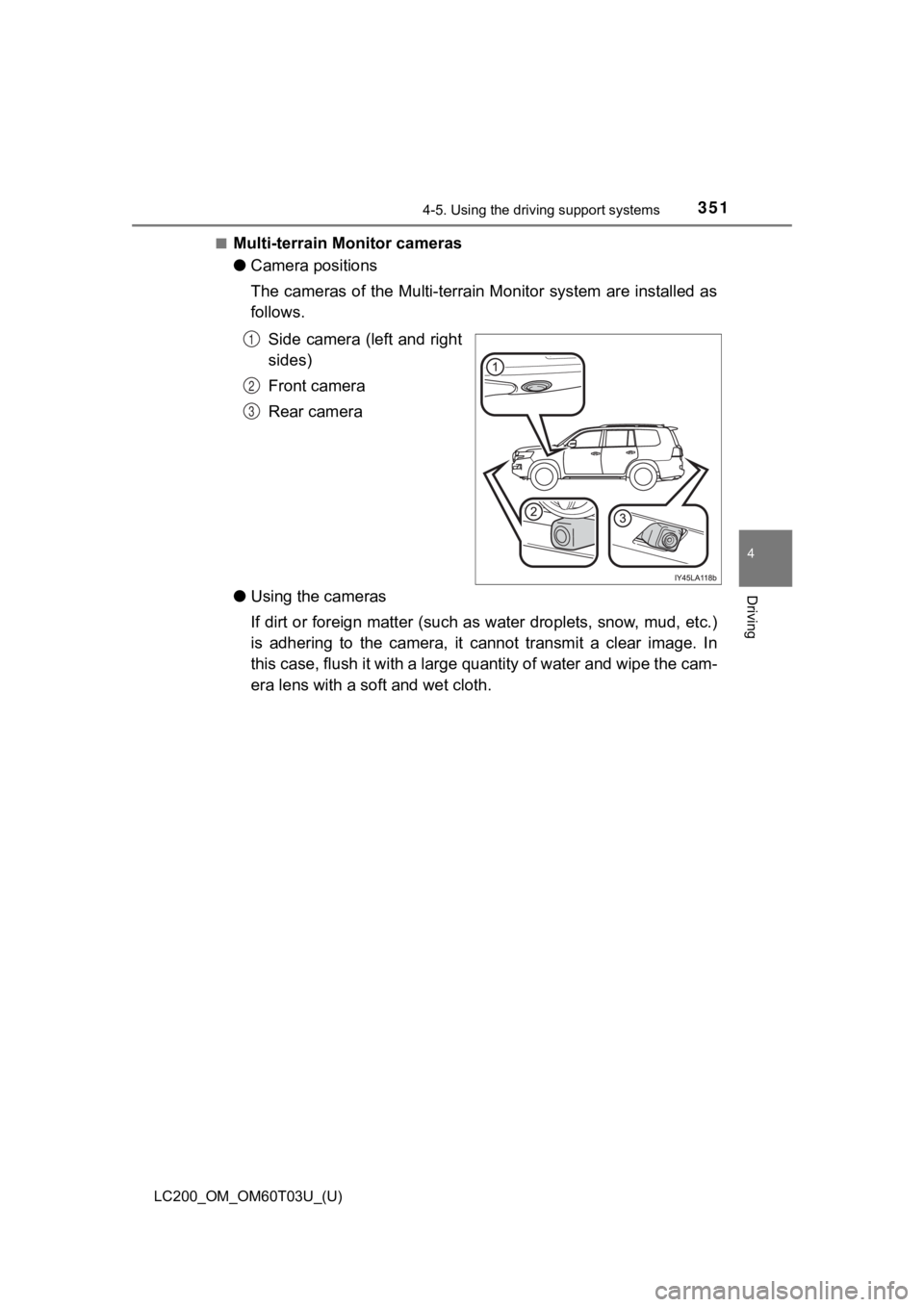
LC200_OM_OM60T03U_(U)
3514-5. Using the driving support systems
4
Driving
■Multi-terrain Monitor cameras
●Camera positions
The cameras of the Multi-terrain Monitor system are installed a s
follows.
Side camera (left and right
sides)
Front camera
Rear camera
● Using the cameras
If dirt or foreign matter (such as water droplets, snow, mud, e tc.)
is adhering to the camera, it cannot transmit a clear image. In
this case, flush it with a large quantity of water and wipe the cam-
era lens with a so ft and wet cloth.
1
2
3
Page 352 of 632
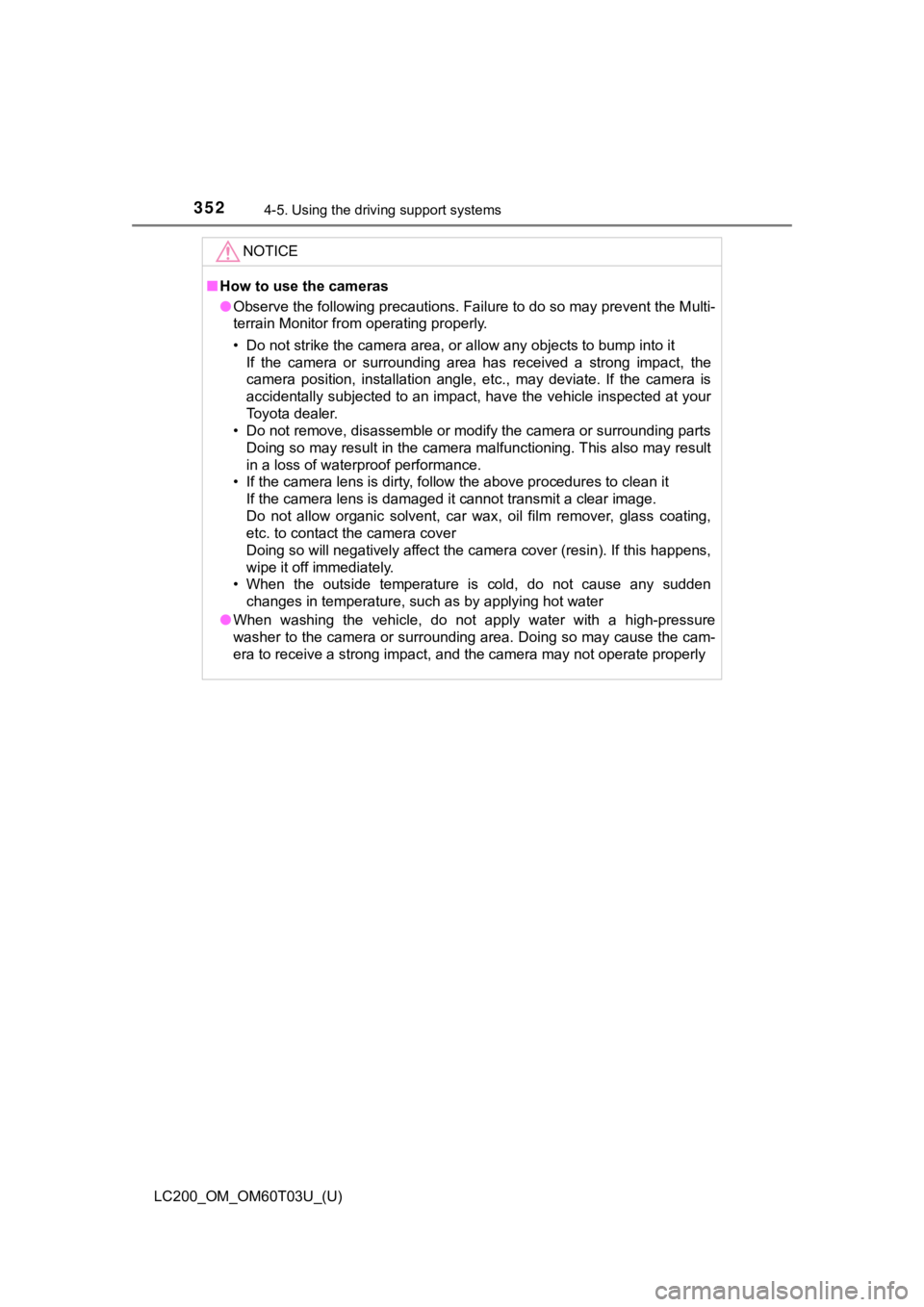
352
LC200_OM_OM60T03U_(U)
4-5. Using the driving support systems
NOTICE
■How to use the cameras
● Observe the following precautions. Failure to do so may prevent the Multi-
terrain Monitor from operating properly.
• Do not strike the camera area, or allow any objects to bump in to it
If the camera or surrounding area has received a strong impact, the
camera position, installation angle, etc., may deviate. If the camera is
accidentally subjected to an impact, have the vehicle inspected at your
Toyota dealer.
• Do not remove, disassemble or modify the camera or surrounding parts Doing so may result in the camera malfunctioning. This also may result
in a loss of waterproof performance.
• If the camera lens is dirty, follow the above procedures to clean it If the camera lens is damaged it cannot transmit a clear image.
Do not allow organic solvent, car wax, oil film remover, glass coating,
etc. to contact the camera cover
Doing so will negatively affect the camera cover (resin). If th is happens,
wipe it off immediately.
• When the outside temperature is cold, do not cause any sudden changes in temperature, such as by applying hot water
● When washing the vehicle, do not apply water with a high-pressu re
washer to the camera or surrounding area. Doing so may cause th e cam-
era to receive a strong impact, and the camera may not operate properly
Page 353 of 632
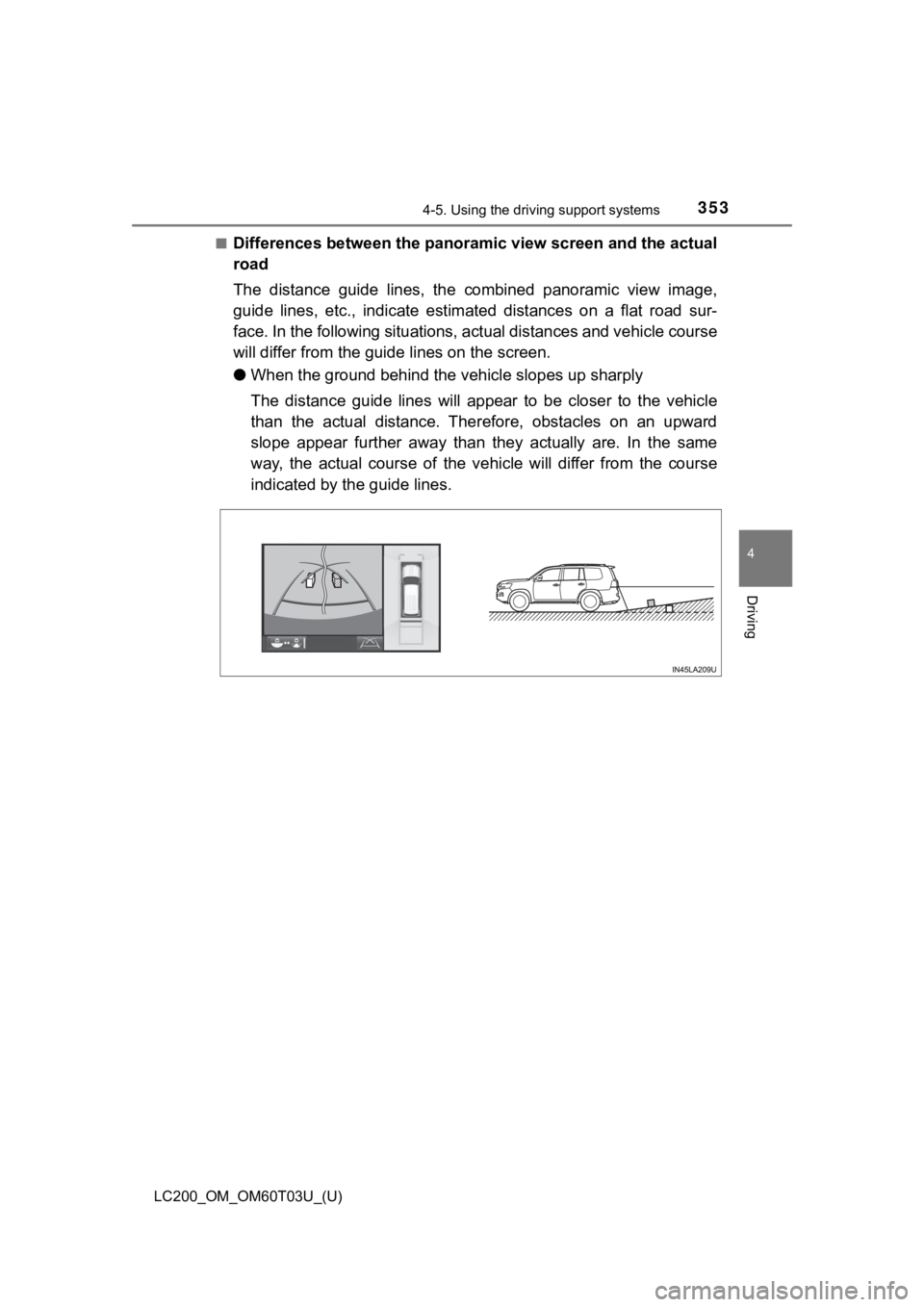
LC200_OM_OM60T03U_(U)
3534-5. Using the driving support systems
4
Driving
■Differences between the panoramic view screen and the actual
road
The distance guide lines, the combined panoramic view image,
guide lines, etc., indicate estimated distances on a flat road sur-
face. In the following situations, actual distances and vehicle course
will differ from the guide lines on the screen.
● When the ground behind the vehicle slopes up sharply
The distance guide lines will appear to be closer to the vehicl e
than the actual distance. Ther efore, obstacles on an upward
slope appear further away than they actually are. In the same
way, the actual course of the ve hicle will differ from the course
indicated by the guide lines.
Page 354 of 632
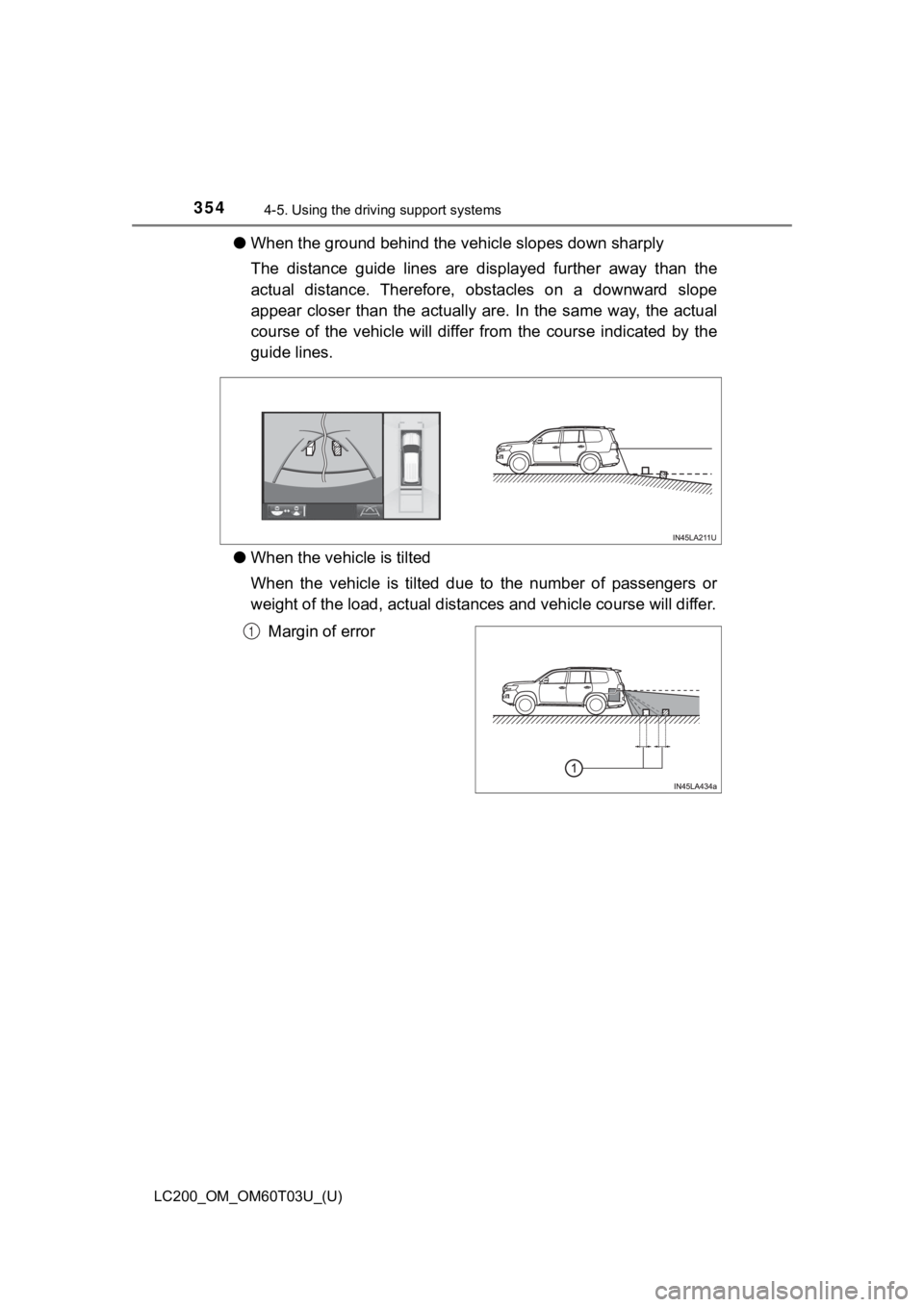
354
LC200_OM_OM60T03U_(U)
4-5. Using the driving support systems
●When the ground behind the ve hicle slopes down sharply
The distance guide lines are displayed further away than the
actual distance. Ther efore, obstacles on a downward slope
appear closer than the actually are. In the same way, the actua l
course of the vehicle will differ from the course indicated by the
guide lines.
● When the vehicle is tilted
When the vehicle is tilted due to the number of passengers or
weight of the load, ac tual distances and vehicle course will di ffer.
Margin of error
1
Page 355 of 632
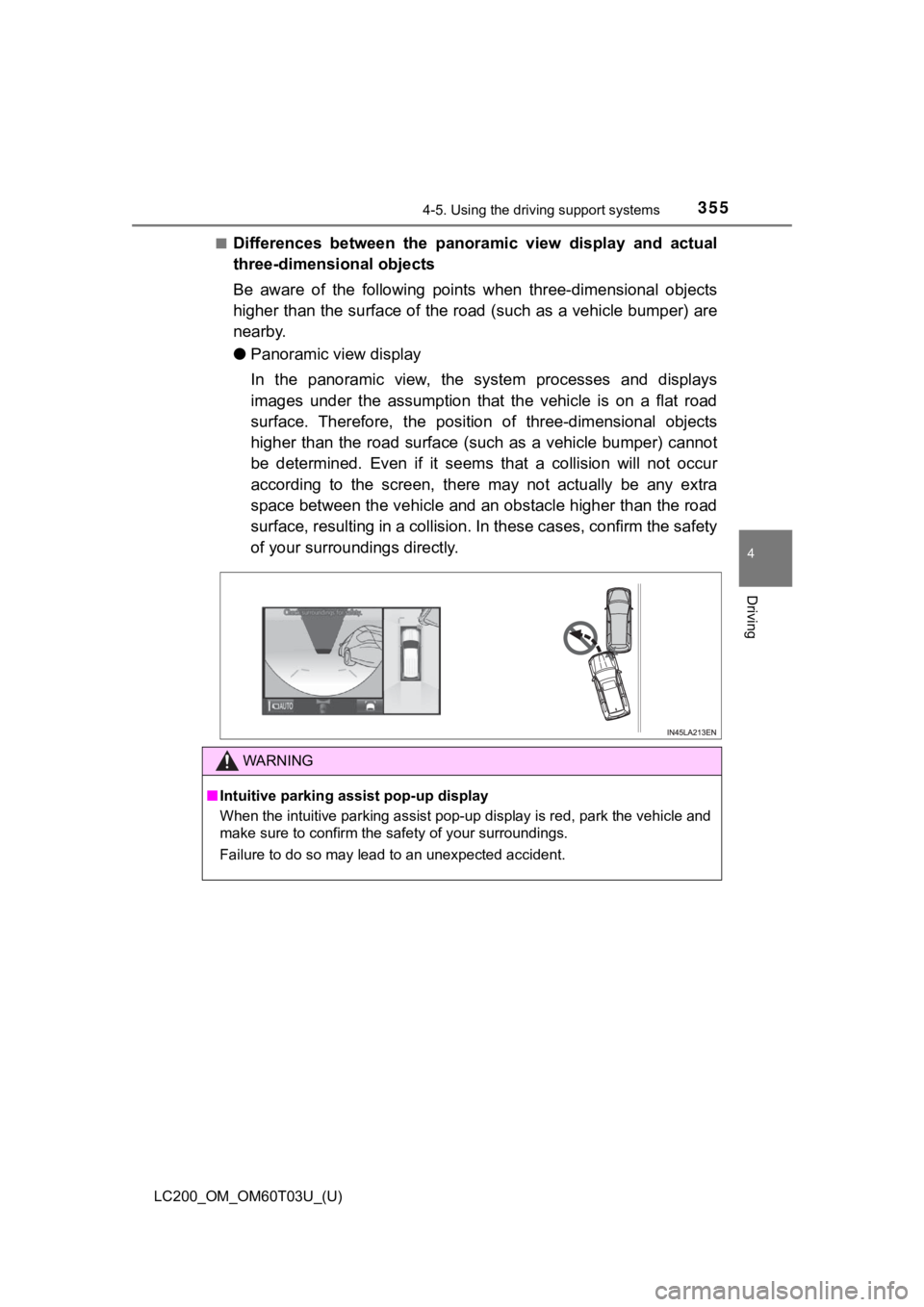
LC200_OM_OM60T03U_(U)
3554-5. Using the driving support systems
4
Driving
■Differences between the panoramic view display and actual
three-dimensional objects
Be aware of the following points when three-dimensional objects
higher than the surface of the road (such as a vehicle bumper) are
nearby.
● Panoramic view display
In the panoramic view, the system processes and displays
images under the assumption that the vehicle is on a flat road
surface. Therefore, the position of three-dimensional objects
higher than the road surface (such as a vehicle bumper) cannot
be determined. Even if it seems that a collision will not occur
according to the screen, there may not actually be any extra
space between the vehicle and an obstacle higher than the road
surface, resulting in a collisi on. In these cases, confirm the safety
of your surroundings directly.
WARNING
■ Intuitive parking assist pop-up display
When the intuitive parking assist pop-up display is red, park t he vehicle and
make sure to confirm the safety of your surroundings.
Failure to do so may lead to an unexpected accident.
Page 356 of 632
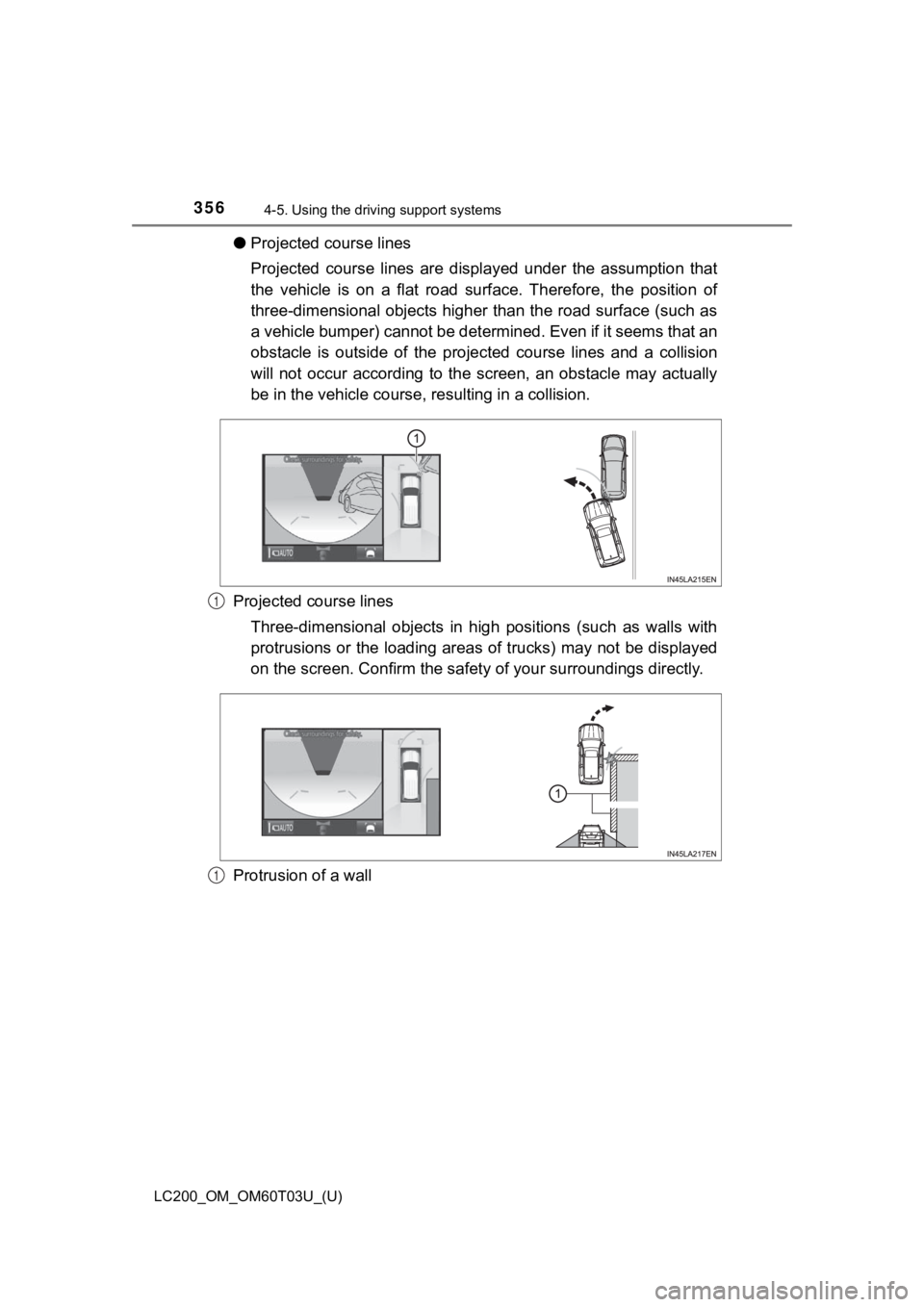
356
LC200_OM_OM60T03U_(U)
4-5. Using the driving support systems
●Projected course lines
Projected course lines are displ ayed under the assumption that
the vehicle is on a flat road surface. Therefore, the position of
three-dimensional objects higher than the road surface (such as
a vehicle bumper) cannot be det ermined. Even if it seems that an
obstacle is outside of the proje cted course lines and a collision
will not occur according to the sc reen, an obstacle may actually
be in the vehicle course, resulting in a collision.
Projected course lines Three-dimensional objects in high positions (such as walls with
protrusions or the loading areas of trucks) may not be displayed
on the screen. Confirm the safet y of your surroundings directly.
Protrusion of a wall
1
1
Page 357 of 632
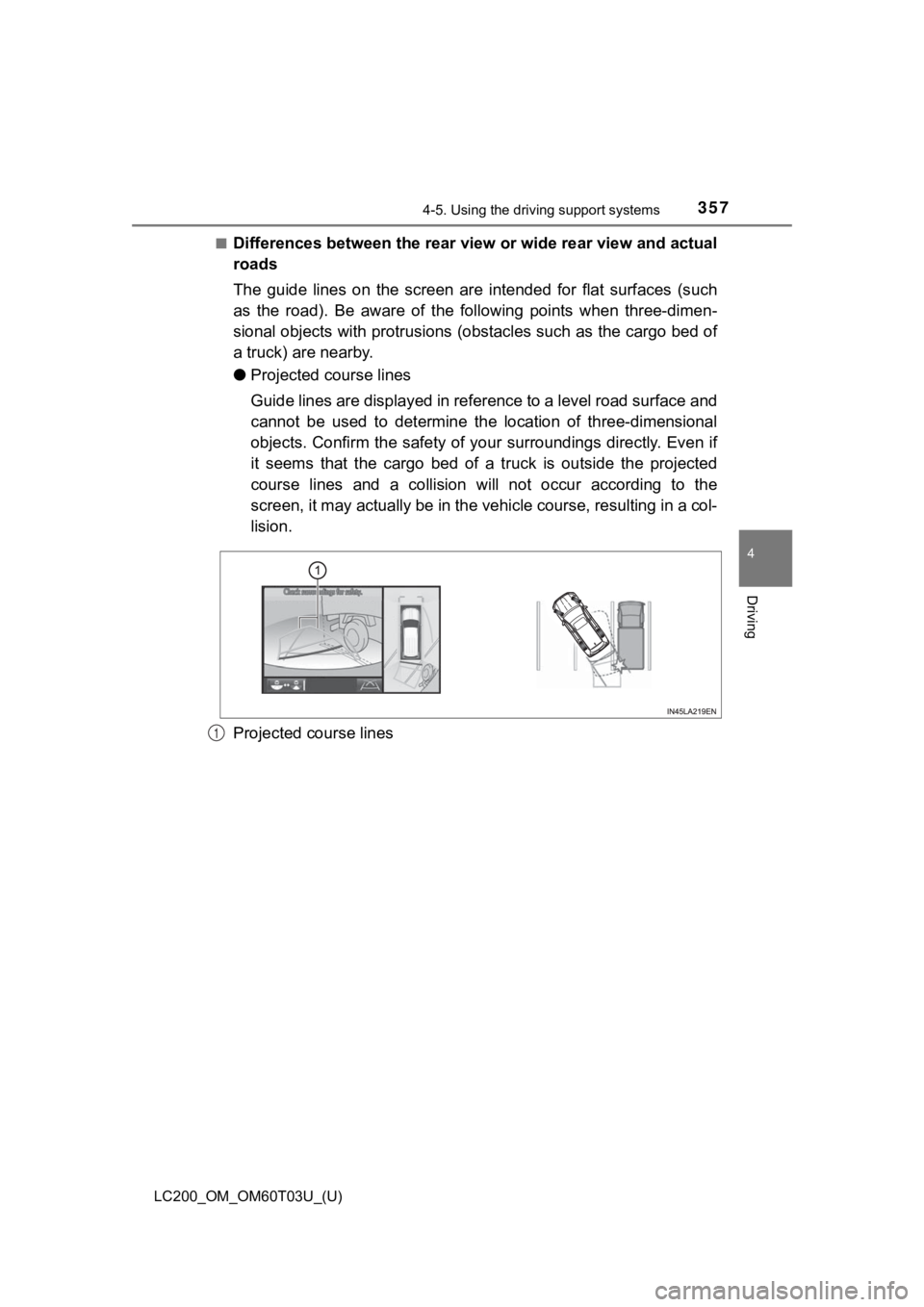
LC200_OM_OM60T03U_(U)
3574-5. Using the driving support systems
4
Driving
■Differences between the rear view or wide rear view and actual
roads
The guide lines on the screen are intended for flat surfaces (s uch
as the road). Be aware of the following points when three-dimen -
sional objects with protrusions ( obstacles such as the cargo bed of
a truck) are nearby.
● Projected course lines
Guide lines are displayed in reference to a level road surface and
cannot be used to determine the location of three-dimensional
objects. Confirm the safety of y our surroundings directly. Even if
it seems that the cargo bed of a t ruck is outside the projected
course lines and a collision w ill not occur according to the
screen, it may actually be in the vehicle course, resulting in a col-
lision.
Projected course lines
1
Page 358 of 632
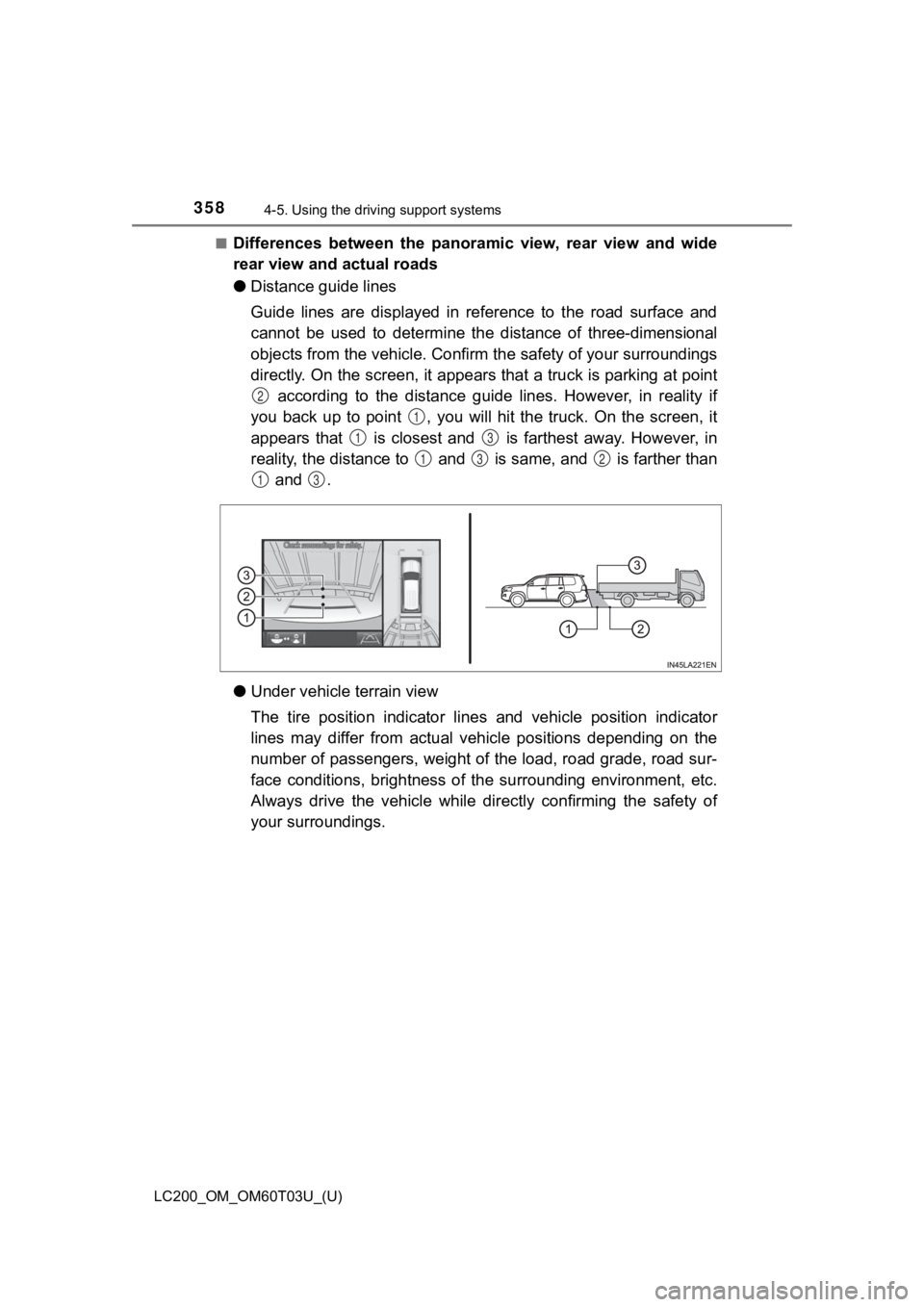
358
LC200_OM_OM60T03U_(U)
4-5. Using the driving support systems
■Differences between the panoramic view, rear view and wide
rear view and actual roads
●Distance guide lines
Guide lines are displayed in reference to the road surface and
cannot be used to determine th e distance of three-dimensional
objects from the vehicle. Confirm the safety of your surroundin gs
directly. On the screen, it appears that a truck is parking at point
according to the distance guide lines. However, in reality if
you back up to point , you will hit the truck. On the screen, i t
appears that is closest and is farthest away. However, in
reality, the distance to and is same, and is farther than and .
● Under vehicle terrain view
The tire position indicator lines and vehicle position indicato r
lines may differ from actual v ehicle positions depending on the
number of passengers, weight of the load, road grade, road sur-
face conditions, brightness of the surrounding environment, etc .
Always drive the vehicle while directly confirming the safety o f
your surroundings.
2
1
13
132
13
Page 359 of 632
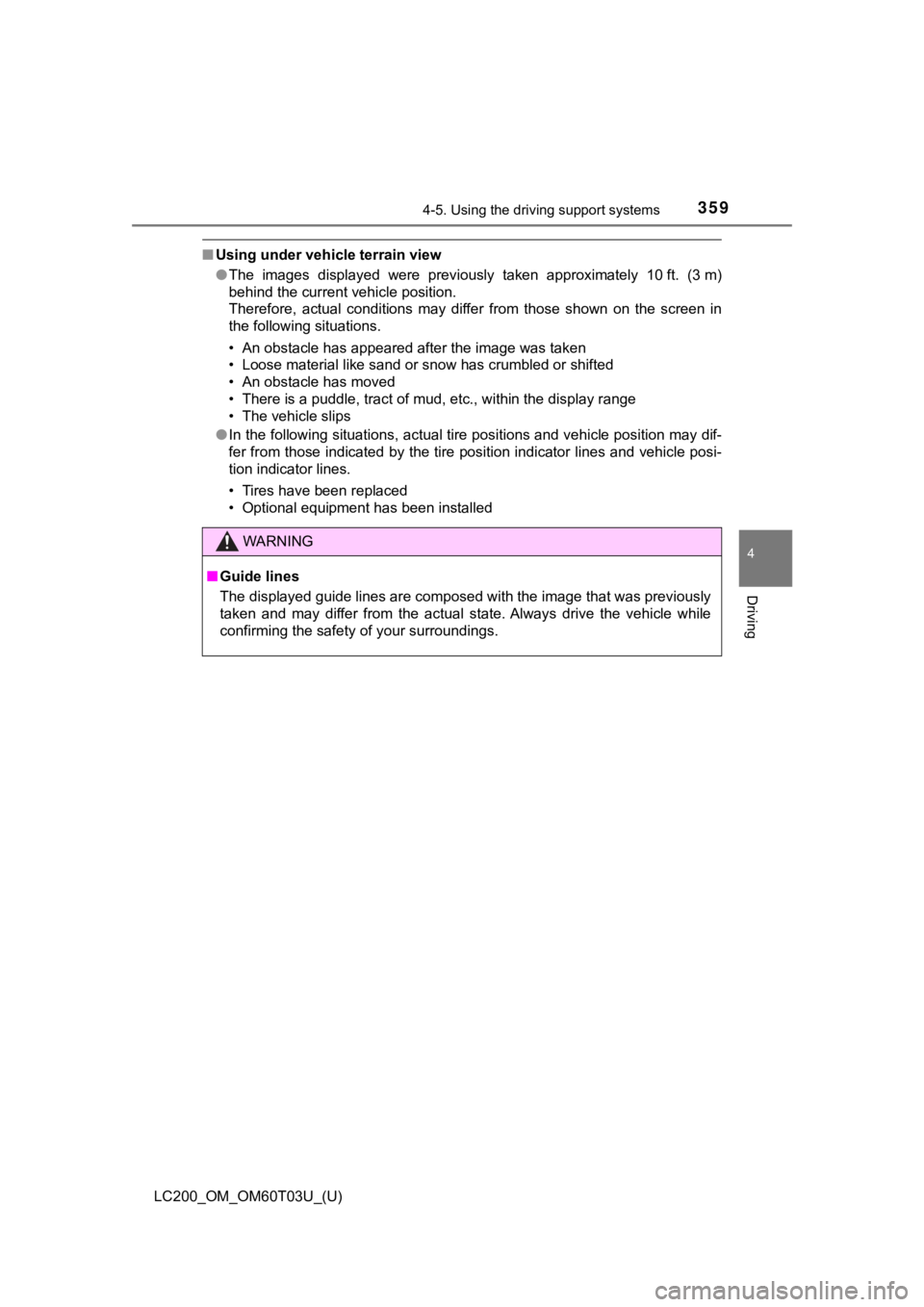
LC200_OM_OM60T03U_(U)
3594-5. Using the driving support systems
4
Driving
■Using under vehicle terrain view
●The images displayed were previously taken approximately 10 ft. (3 m)
behind the current vehicle position.
Therefore, actual conditions may differ from those shown on the screen in
the following situations.
• An obstacle has appeared after the image was taken
• Loose material like sand or snow has crumbled or shifted
• An obstacle has moved
• There is a puddle, tract of mud, etc., within the display rang e
• The vehicle slips
● In the following situations, actual tire positions and vehicle position may dif-
fer from those indicated by the tire position indicator lines and vehicle posi-
tion indicator lines.
• Tires have been replaced
• Optional equipment has been installed
WARNING
■Guide lines
The displayed guide lines are composed with the image that was previously
taken and may differ from the actual state. Always drive the vehicle while
confirming the safety of your surroundings.
Page 360 of 632
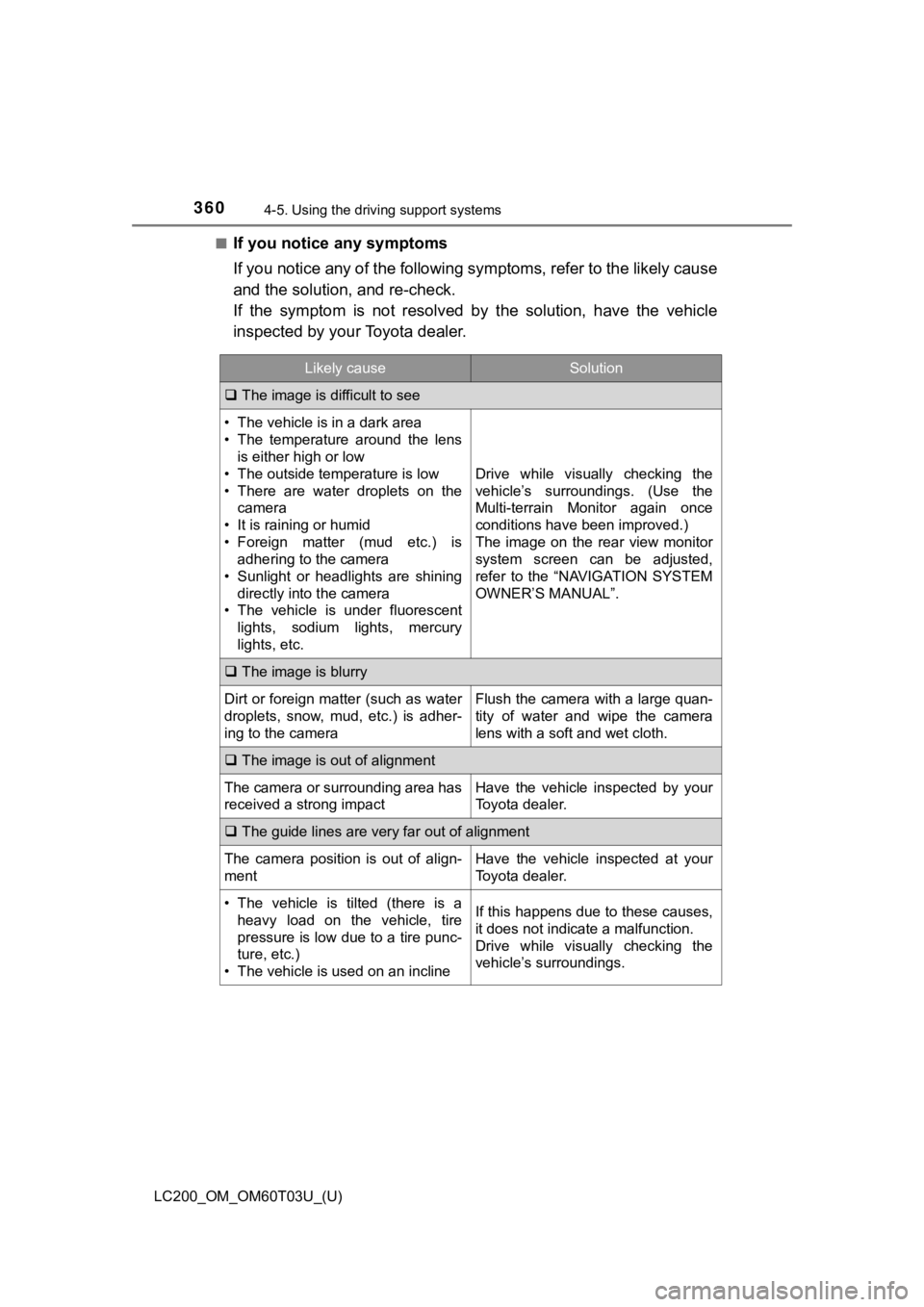
360
LC200_OM_OM60T03U_(U)
4-5. Using the driving support systems
■If you notice any symptoms
If you notice any of the followi ng symptoms, refer to the likel y cause
and the solution, and re-check.
If the symptom is not resolved by the solution, have the vehicl e
inspected by your Toyota dealer.
Likely causeSolution
The image is difficult to see
• The vehicle is in a dark area
• The temperature around the lens
is either high or low
• The outside temperature is low
• There are water droplets on the camera
• It is raining or humid
• Foreign matter (mud etc.) is adhering to the camera
• Sunlight or headlights are shining directly into the camera
• The vehicle is under fluorescent
lights, sodium lights, mercury
lights, etc.
Drive while visually checking the
vehicle’s surroundings. (Use the
Multi-terrain Monitor again once
conditions have been improved.)
The image on the rear view monitor
system screen can be adjusted,
refer to the “NAVIGATION SYSTEM
OWNER’S MANUAL”.
The image is blurry
Dirt or foreign matter (such as water
droplets, snow, mud, etc.) is adher-
ing to the cameraFlush the camera with a large quan-
tity of water and wipe the camera
lens with a soft and wet cloth.
The image is out of alignment
The camera or surrounding area has
received a strong impactHave the vehicle inspected by your
Toyota dealer.
The guide lines are very far out of alignment
The camera position is out of align-
mentHave the vehicle inspected at your
Toyota dealer.
• The vehicle is tilted (there is a
heavy load on the vehicle, tire
pressure is low due to a tire punc-
ture, etc.)
• The vehicle is used on an inclineIf this happens due to these causes,
it does not indicate a malfunction.
Drive while visually checking the
vehicle’s surroundings.